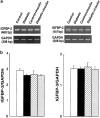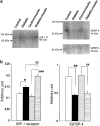Possible involvement of IGF-1 receptor and IGF-binding protein in insulin-induced enhancement of noradrenaline response in diabetic rat aorta
- PMID: 12970107
- PMCID: PMC1574034
- DOI: 10.1038/sj.bjp.0705438
Possible involvement of IGF-1 receptor and IGF-binding protein in insulin-induced enhancement of noradrenaline response in diabetic rat aorta
Abstract
1. We investigated the mechanisms underlying the changes in vascular contractile responsiveness induced by chronic treatment with insulin in controls and established streptozotocin (STZ)-induced diabetic rats. 2. The aortic contractile response to noradrenaline (NA) showed no significant difference between controls and diabetics, but it was significantly greater in insulin-treated diabetic rats than in the other groups. To investigate the mechanism, we examined the changes in NA-induced contractility following treatment with insulin and insulin-like growth factor-1 (IGF-1) in organ-cultured control and diabetic aortas. 3. The contractile response to NA in organ-cultured diabetic rat aortas treated with insulin (500 ng ml-1, 16 h) or IGF-1 (20 ng ml-1, 16 h) was significantly greater than the corresponding values for (a) diabetic rat aortas cultured in serum-free medium, and (b) control aortas incubated with insulin or IGF-1. Incubating control aortas with insulin or IGF-1 had no significant effect on the contraction induced by NA. 4. The expressions of the IGF-1 receptor mRNA and protein were increased in STZ-induced diabetic aortas and further increased in insulin-treated diabetics. The mRNA expressions of IGF-binding protein (IGFBP)-2 and IGFBP-3 were normal in diabetic aortas. In contrast, those of IGFBP-4 and IGFBP-5 were significantly decreased in diabetic aortas, and not restored by insulin treatment. 5. These results suggest that the insulin deficiency and chronic hyperinsulinemia in diabetes upregulate the IGF-1 receptor and downregulate IGFBP-4 and IGFBP-5 in the aorta. This may be a major cause of the increased vascular contractility induced by insulin administration and by hyperinsulinemia in established diabetes, resulting in hypertension.
Figures







Similar articles
-
IGF-I-induced enhancement of contractile response in organ-cultured aortae from diabetic rats is mediated by sustained thromboxane A2 release from endothelial cells.J Endocrinol. 2005 Aug;186(2):367-76. doi: 10.1677/joe.1.06222. J Endocrinol. 2005. PMID: 16079262
-
[Possible involvement of IGF-1 receptor and IGF-binding protein in insulin-induced enhancement of noradrenaline response in diabetic rat aorta].Nihon Yakurigaku Zasshi. 2003 Nov;122 Suppl:40P-42P. Nihon Yakurigaku Zasshi. 2003. PMID: 14727518 Japanese.
-
IGF-I differentially regulates IGF-binding protein expression in primary mammary fibroblasts and epithelial cells.J Endocrinol. 2005 Jul;186(1):165-78. doi: 10.1677/joe.1.06164. J Endocrinol. 2005. PMID: 16002546
-
Growth promotion by insulin-like growth factor I in hypophysectomized and diabetic rats.Mol Cell Endocrinol. 1998 May 25;140(1-2):143-9. doi: 10.1016/s0303-7207(98)00042-2. Mol Cell Endocrinol. 1998. PMID: 9722182 Review.
-
In vitro studies of insulin-like growth factor I and bone.Growth Horm IGF Res. 2000 Apr;10 Suppl B:S107-10. doi: 10.1016/s1096-6374(00)80020-9. Growth Horm IGF Res. 2000. PMID: 10984264 Review.
Cited by
-
Prevention of hyperglycemic signal pathways in metabolic syndrome carotid artery of rats.Transl Stroke Res. 2012 Dec;3(4):466-72. doi: 10.1007/s12975-012-0205-6. Epub 2012 Aug 14. Transl Stroke Res. 2012. PMID: 24323833
-
Molecular Study of the Protective Effect of a Low-Carbohydrate, High-Fat Diet against Brain Insulin Resistance in an Animal Model of Metabolic Syndrome.Brain Sci. 2023 Sep 28;13(10):1383. doi: 10.3390/brainsci13101383. Brain Sci. 2023. PMID: 37891752 Free PMC article.
-
Vimentin and laminin are altered on cheek pouch microvessels of streptozotocin-induced diabetic hamsters.Clinics (Sao Paulo). 2011;66(11):1961-8. doi: 10.1590/s1807-59322011001100018. Clinics (Sao Paulo). 2011. PMID: 22086529 Free PMC article.
-
Enhanced uridine adenosine tetraphosphate-induced contraction in renal artery from type 2 diabetic Goto-Kakizaki rats due to activated cyclooxygenase/thromboxane receptor axis.Pflugers Arch. 2014 Feb;466(2):331-42. doi: 10.1007/s00424-013-1330-0. Epub 2013 Jul 31. Pflugers Arch. 2014. PMID: 23900807
-
Mechanisms underlying lysophosphatidylcholine-induced potentiation of vascular contractions in the Otsuka Long-Evans Tokushima Fatty (OLETF) rat aorta.Br J Pharmacol. 2006 Dec;149(7):931-41. doi: 10.1038/sj.bjp.0706937. Epub 2006 Oct 9. Br J Pharmacol. 2006. PMID: 17031383 Free PMC article.
References
-
- ABE H., YAMADA N., KAMATA K., KUWAKI T., SHIMADA M., OSUGA J., SHIONOIRI F., YAHAGI N., KADOWAKI T., TAMEMOTO H., ISHIBASHI S., YAZAKI Y., MAKUUCHI M. Hypertension, hypertriglyceridemia, and impaired endothelium-dependent vascular relaxation in mice lacking insulin receptor substrate-1. J. Clin. Invest. 1998;101:1784–1788. - PMC - PubMed
-
- ANWAR A., ZAHID A.A., PHILLIPS L., DELAFONTAINE P. Insulin-like growth factor binding protein-4 expression is decreased by angiotensin II and thrombin in rat aortic vascular smooth muscle cells. Arterioscler. Thromb. Vasc. Biol. 2000;20:370–376. - PubMed
-
- BAYES-GENIS A., CONOVER C.A., SCHWARTZ R.S. The insulin-like growth factor axis: a review of atherosclerosis and restenosis. Circ. Res. 2000;86:125–130. - PubMed
-
- BLAKESLEY V.A., SCRIMGEOUR A., ESPOSITO D., LE ROITH D. Signaling via the insulin-like growth factor-I receptor: does it differ from insulin receptor signaling. Cytokine Growth Factor Rev. 1996;7:153–159. - PubMed
-
- BORNFELDT K.E., ARNQVIST H.J., CAPRON L. In vivo proliferation of vascular smooth muscle in relation to diabetes mellitus, insulin-like growth factor I and insulin. Diabetologia. 1992;35:104–108. - PubMed
Publication types
MeSH terms
Substances
LinkOut - more resources
Full Text Sources
Medical
Miscellaneous

